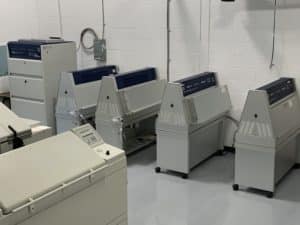ASTM D4585
Standard Practice for Testing Water Resistance of Coatings Using Controlled Condensation
Micom offers ASTM D4585 testing as part of its polymer testing services. This standard describes an accelerated aging test which allows to assess the water resistance of coatings through the use of controlled condensation. More specifically, this practice states the principles and the operating conditions that required to achieve consistent results from lab to lab. Moreover, ASTM D4585 does not provide any indications regarding the preparation of the specimen, the specific test conditions, nor does it offer any guidance or requirements for the evaluation of the results. Lastly, the ASTM D1735 and the ASTM D2247 standards are alternatives of this practice.
Testing Water Resistance of coating using controlled Condensation—use and factors to consider:
 The purpose of ASTM D4585 is to assess the capacity of a coating to resist deterioration that is caused by water through the use of a condensation test. Indeed, the latter consists of exposing a sample to a controlled temperature environment with a saturated vapor and these kinds of test results in a pass or fail determination. Furthermore, this test can evaluate the coating or the complete coating system because the damages observed in this test may be caused by various factors. For example, failures may be provoked by: substrate contamination, inadequate surface preparation or by the coating itself. In order to gauge the water resistance of the sample, this test relies on the assessment of aesthetics characteristics such as: color change, blistering, the loss of adhesion and softening that thoroughly described in other standards. Lastly, by evaluating water resistance of the coating, it is possible to foresee its performance in the field.
The purpose of ASTM D4585 is to assess the capacity of a coating to resist deterioration that is caused by water through the use of a condensation test. Indeed, the latter consists of exposing a sample to a controlled temperature environment with a saturated vapor and these kinds of test results in a pass or fail determination. Furthermore, this test can evaluate the coating or the complete coating system because the damages observed in this test may be caused by various factors. For example, failures may be provoked by: substrate contamination, inadequate surface preparation or by the coating itself. In order to gauge the water resistance of the sample, this test relies on the assessment of aesthetics characteristics such as: color change, blistering, the loss of adhesion and softening that thoroughly described in other standards. Lastly, by evaluating water resistance of the coating, it is possible to foresee its performance in the field.
The main factors that are to be considered when running this test are: the time of exposure, the temperature and the periodic drying of the specimen.
Typical Experimental parameters:
The number of samples required is two and it is recommended to test them alongside a material of known performance, so that the latter one can be used as a control. The minimum sample size is 76 mm wide by 152 mm tall with a maximum thickness of 8 mm (3 in wide X 6 in tall X ¾ in thick). Table 1 lists the typical conditions of the test.
Table I: Typical conditions of the test
| Parameters | Specifications |
| Temperature of the test | To be specified, but typically from 38 to 82 °C (100 to 180 °F) |
| Duration of the test | To be specified |
| Vapor temperature | 38, 49 or 60 °C (100, 120 or 140 °F) |
| Difference of temperature between the room | At least 11 °C |
| and the vapor | |
| Exposure cycles | Condensation period only |
| Cyclic operation between a condensation and a drying period may be employed The drying period should be at least 4h |
Other test methods related to ASTM D4585:
For additional related test methods, please see ASTM D2244, ASTM D714, ASTM D3359, ASTM D2240
If you have any questions about the ASTM D4585 test, we invite you to contact our material testing lab today. It will be our pleasure to answer your questions and help you with your custom material testing requirements.

